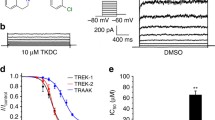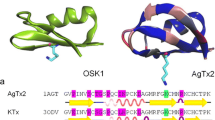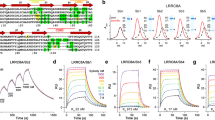Abstract
Zervamicin-IIB (Zrv-IIB) is a 16 residue peptaibol which forms voltage-activated, multiple conductance level channels in planar lipid bilayers. A molecular model of Zrv-IIB channels is presented. The structure of monomerc Zrv-II3 is based upon the crystal structure of Zervamicin-Leu. The helical backbone is kinked by a hydroxyproline residue at position 10. Zrv-IIB channels are modelled as helix bundles of from 4 to 8 parallel helices surrounding a central pore. The monomers are packed with their C-terminal helical segments in close contact, and the bundles are stabilized by hydrogen bonds between glutamine 11 and hydroxyproline 10 of adjacent helices. Interaction energy profiles for movement of three different probes species (K+, Cl− and water) through the central pore are analyzed. The conformations of: (a) the sidechain of glutamine 3; (b) the hydroxyl group of hydroxyproline 10; and (c) the C-terminal hydroxyl group are “optimized” in order to maximize favourable interactions between the channel and the probes, resulting in favourable interaction energy profiles for all three. This suggests that conformational flexibility of polar sidechains enables the channel lining to mimic an aqueous environment.
Similar content being viewed by others
References
Agarwalla S, Mellor IR, Sansom MSP, Karle IL, Flippen-Anderson JL, Uma K, Krishna K, Sukumar M, Balaram P (1992) Zervamicins, a structurally characterised peptide model for membrane ion channels. Biochem Biophys Res Commun 186: 8–15
Balaram P, Sukumar M, Krishna K, Mellor IR, Sansom MSP (1992) The properties of ion channels formed by zervamicins. Eur Biophys J 21: 117–128
Boheim G, Gellert S, Jung G, Menestrina G (1987) α-Helical ion channels reconstituted into planar bilayers. In: Yagi K, Pullman B (eds) Ion transport through membranes. Academic Press, Tokyo, pp 131–145
Brooks BR, Bruccoleri RE, Olafson BD, States DJ, Swaminathan S, Karplus M (1983) CHARMM: a program for macromolecular energy, minimization, and dynamics calculations. J Comp Chem 4: 187–217
Brünger AT, Karplus M (1988) Polar hydrogen positions in proteins: empirical energy placement and neutron diffraction comparison. Proteins: Struct Func Genet 4: 148–156
Esposito G, Carver JA, Boyd J, Campbell ID (1987) High resolution 1H NMR study of the solution structure of alamethicin. Biochem 26: 1043–1050
Fox RO, Richards FM (1982) A voltage-gated ion channel model inferred from the crystal strcture of alamethicin at 1.5 Å resolution. Nature 300: 325–330
Furois-Corbin S, Pullman A (1986) Theoretical study of the packing of α-helices by energy minimization: effect of the length of the helices on the packing energy and on the optimal configuration of a pair. Chem Phys Lett 123: 305–310
Furois-Corbin S, Pullman A (1991) The effect of point mutations on energy profiles in a model of the nicotinic acetylcholine receptor (AChR) channel. Biophys Chem 39: 153–159
Goodford PJ (1985) A computational procedure for determining energetically favorable binding sites on biologically important macromolecules. J Med Chem 28: 849–857
Hall JE, Vodyanoy I, Balasubramanian TM, Marshall GR (1984) Alamethicin: a rich model for channel behaviour. Biophys J 45: 233–247
Hoch JC, Dobson CM, Karplus M (1985) Vicinal coupling constants and protein dynamics. Biochem 24: 3831–3841
Hol WG, von Duijen PT, Berendsen HJC (1978) The α-helix dipole and the properties of proteins. Nature 273: 443–446
Janin J, Wodak S, Levitt M, Maigret B (1978) Conformations of amino acid sidechains in proteins. J Mol Biol 125: 357–386
Jeffrey GA, Saenger W (1991) Hydrogen bonding in biological structures. Springer, Berlin Heidelberg New York
Karle IL, Flippen-Andersen J, Agarwalla S, Balaram P (1991) Crystal structure of Leu-zervamicin, a membrane ion channel peptide. Implications for gating mechanisms. Proc Natl Acad Sci USA 88: 5307–5311
Karle IL, Flippen-Andersen J, Sukumar M, Balaram P (1987) Conformation of a 16-residue zervamicin IIA analog peptide containing 3 different structural features: 310-helix, α-helix and β-bend ribbon. Proc Natl Acad Sci USA 84: 5087–5091
Kerr ID, Sansom MSP (1992) Hydrophilic surface maps of α-helical channel-forming peptides (manuscript in preparation)
Kossiakoff AA, Shpungin J, Sintchak MD (1990) Hydroxyl hydrogen conformations in trypsin determined by the neutron diffraction solvent difference map method: relative importance of steric and electrostatic factors in defining hydrogen-bonding geometries. Proc Natl Acad Sci USA 87: 4468–4472
Kraulis PJ (1991) MOLSCRIPT: a program to produce both detailed and schematic plots of protein structures. J Appl Cryst 24: 946–950
Krishna K, Sukumar M, Balaram P (1990) Structural chemistry and membrane modifying activity of the fungal polypeptides zervamicins, antiamoebins and efrapeptins. Pure Appl Chem 62: 1417–1420
Lear JD, Wasserman ZR, DeGrado WF (1988) Synthetic amphiphilic peptide models for protein ion channels. Science 240: 1177–1181
Mathew MK, Balaram P (1983) A helix dipole model for alamethicin and related transmembrane channels. FEBS Lett 157: 1–5
Nagaraj R, Balaram P (1981) Alamethicin, a transmembrane channel. Ace Chem Res 14: 356–362
Nilges M, Brünger AT (1991) Automated modeling of coiled coils: application to the GCN4 dimerization region. Prot Engineer 4: 649–659
Rinehart KL, Gaudioso LA, Moore ML, Pandey RC, Cok JC, Brber M, Sedgwick D, Bordoli RS, Tyler AN, Green BN (1981) Structures of eleven zervamicin and two emerimicin peptide antibiotics studied by fast atom bombardment mass spectroscopy. J Am Chem Soc 103: 6517–6520
Sansom MSP (1991) The biophysics of peptide models of ion channels. Prog Biophys Mol Biol 55: 139–235
Sansom MSP (1992 a) Proline residues in transmembrane helices of channel and transport proteins: a molecular modelling study. Prot Engineer 5: 53–60
Sansom MSP (1992 b) An investigation of the role of serine and threonine sidechains in ion channel proteins. Eur Biophys J 21: 281–298
Sansom MSP (1992 c) Sidechain-ion interactions in ion channels: a molecular modelling study. Biochem Soc Trans 20: 254
Sansom MSP, Kerr ID, Mellor IR (1991) Ion channels formed by amphipathic helical peptides — a molecular modelling study. Eur Biophys J 20: 229–240
Schifffer M, Chang CH, Stevens FJ (1992) The functions of tryptophan residues in membrane proteins. Prot Engineer 5: 213–214
Spach G, Merle Y, Molle G (1985) Peptide amphiphiles et canaux transmembranes. J Chim Phys 82: 719–721
Toyoshima C, Unwin N (1990) Three-dimensional structure of the acetylcholine receptor by cryoelectron microscopy and helical image reconstruction. J Cell Biol 111: 2623–2635
Author information
Authors and Affiliations
Rights and permissions
About this article
Cite this article
Sansom, M.S.P., Balaram, P. & Karle, I.L. Ion channel formation by zervamicin-IIB. Eur Biophys J 21, 369–383 (1993). https://doi.org/10.1007/BF00185864
Received:
Accepted:
Issue Date:
DOI: https://doi.org/10.1007/BF00185864




